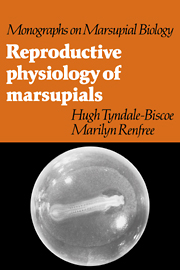Book contents
- Frontmatter
- Contents
- Preface
- 1 Historical introduction
- 2 Breeding biology of marsupials by family
- 3 Sexual differentiation and development
- 4 Male anatomy and spermatogenesis
- 5 The female urogenital tract and oogenesis
- 6 Ovarian function and control
- 7 Pregnancy and parturition
- 8 Lactation
- 9 Neuroendocrine control of seasonal breeding
- 10 Marsupials and the evolution of mammalian reproduction
- References
- Index
2 - Breeding biology of marsupials by family
Published online by Cambridge University Press: 06 January 2010
- Frontmatter
- Contents
- Preface
- 1 Historical introduction
- 2 Breeding biology of marsupials by family
- 3 Sexual differentiation and development
- 4 Male anatomy and spermatogenesis
- 5 The female urogenital tract and oogenesis
- 6 Ovarian function and control
- 7 Pregnancy and parturition
- 8 Lactation
- 9 Neuroendocrine control of seasonal breeding
- 10 Marsupials and the evolution of mammalian reproduction
- References
- Index
Summary
The most recent checklist of living marsupials is that of Kirsch & Calaby (1977) and their nomenclature is used throughout this book except for more recent revisions in the Dasyuridae reported by Archer (1982). Kirsch & Calaby (1977) recognise 249 species in 16 families. Sixty species live in the Americas and the rest in Australia or the New Guinea islands. They range in size from 7 g to 90 kg and occupy rainforest, dry woodlands, open grasslands and semi-desert from sea level to altitudes of 3000 m in New Guinea and South America. Some are carnivorous, some insectivorous, others are arboreal folivores and others grazers or browsers (see Hume, 1982). Of these species there is now substantial information about the reproduction of 32 species representing 6 families and moderate or slight information about a further 45 species (Tables 2.1 and 2.2). In compiling the material for this chapter we have drawn extensively on the reviews of Collins (1973), Hunsaker (1977), Hunsaker & Shupe (1977) and Charles-Dominique (1983) for neotropical marsupials, Strahan (1983) for Australian marsupials, Archer (1982) for Dasyuridae, Smith & Hume (1984) for Phalangeroidea and Tyndale-Biscoe, Hearn & Renfree (1974) and Tyndale-Biscoe (1984) for the Macropodidae.
Russell (1982a) has provided a fine review of the maternal contribution to reproduction in marsupials, which emphasises the importance of adult body size in reproduction and the constraints it imposes on the strategies adopted by various species. For marsupials there are other constraints as well, which need to be borne in mind when reviewing reproductive patterns systematically.
- Type
- Chapter
- Information
- Reproductive Physiology of Marsupials , pp. 14 - 94Publisher: Cambridge University PressPrint publication year: 1987
- 5
- Cited by



